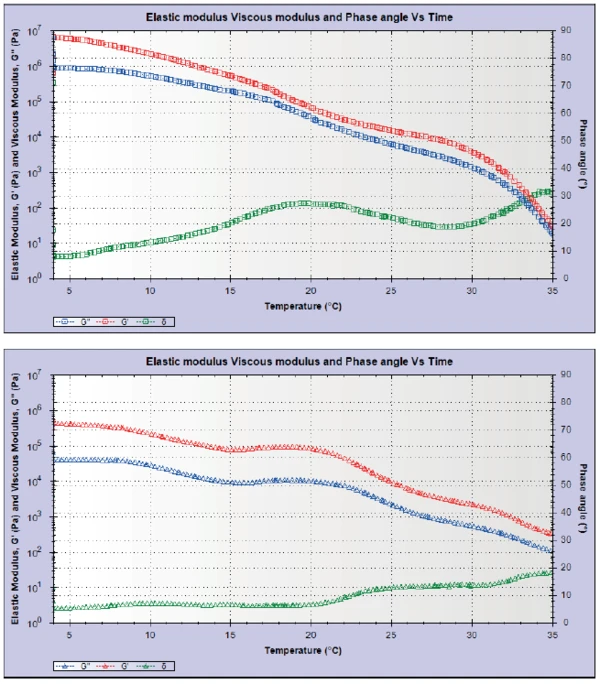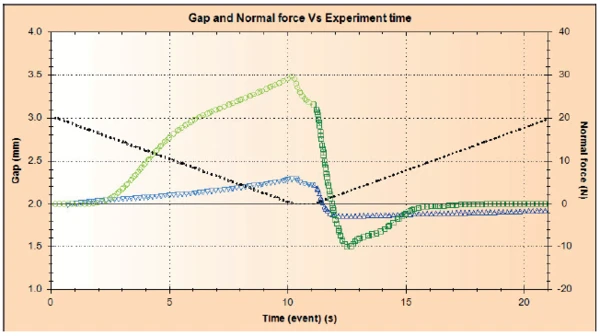Introduction
Butter is a multiphase emulsion consisting of fat globules, crystalline fat and an aqueous phase dispersed in a continuous oil phase. Along with taste, the most important properties of butter in terms of customer perception are texture, appearance and spreadability. Hardness and spreadability are inversely related to each other and are also the two most commonly measured properties of butter (Wright 2001). Both are known to be heavily dependent on temperature but will also be affected by the cooling rate post churning, and regional or seasonal variation caused by a cow’s diet (Prentice 1972).
Rheology can be a useful tool in characterizing and optimizing the textural properties of butter. The shear modulus is related to product stiffness, which can be measured as a function of temperature using oscillatory testing, and the yield StressStress is defined as a level of force applied on a sample with a well-defined cross section. (Stress = force/area). Samples having a circular or rectangular cross section can be compressed or stretched. Elastic materials like rubber can be stretched up to 5 to 10 times their original length.stress represents the StressStress is defined as a level of force applied on a sample with a well-defined cross section. (Stress = force/area). Samples having a circular or rectangular cross section can be compressed or stretched. Elastic materials like rubber can be stretched up to 5 to 10 times their original length.stress that must overcome for the butter to deform plastically, i.e., spreading. Modern rheometers such as the Kinexus rotational rheometer also have advanced axial capabilities which can be useful for investigating other characteristics of butter such as hardness (compressability) and tack (stickiness).
This application note shows how rheology can be used to compare the melting characteristics and spreading characteristics of two commercial products – a normal butter and a spreadable butter. The normal butter was made from milk fat only whereas the spreadable butter contained a percentage of vegetable oil to reduce the Melting Temperatures and EnthalpiesThe enthalpy of fusion of a substance, also known as latent heat, is a measure of the energy input, typically heat, which is necessary to convert a substance from solid to liquid state. The melting point of a substance is the temperature at which it changes state from solid (crystalline) to liquid (isotropic melt).melting temperature and stiffness of the material when removed from the fridge.
Experimental
- The two butter samples were evaluated over the temperature range 4°C to 35°C using small amplitude oscillatory testing and axial testing.
- Measurements were made using a Kinexus rheometer with a Peltier plate cartridge and a roughened plateplate measuring system and utilizing pre-configured sequences in the rSpace software.
- A standard loading sequence was used to ensure that the samples were subject to a consistent thermal history and loading protocol.
- A single frequency StrainStrain describes a deformation of a material, which is loaded mechanically by an external force or stress. Rubber compounds show creep properties, if a static load is applied.strain-controlled temperature ramp test was performed between 4°C and 35°C at a rate of 2°C/min using a StrainStrain describes a deformation of a material, which is loaded mechanically by an external force or stress. Rubber compounds show creep properties, if a static load is applied.strain within the Linear Viscoelastic Region (LVR).
- An axial compression-decompression cycle was performed at 4°C on 1 mm of fresh sample and the normal force response measured to determine hardness and tack.
Findings and Discussion
Oscillatory Testing
Small amplitude oscillatory testing is a non-destructive test and can therefore show changes occurring in a complex microstructure with time or temperature without breaking it down. The parameters commonly measured are G’, the elastic (storage) modulus, and G”, the viscous (loss) modulus. These correspond to the stiffness of the solid-like and liquid-like components of the sample respectively, with the total stiffness given by the Complex ModulusThe complex modulus consists of two components, the storage and the loss moduli. The storage modulus (or Young’s modulus) describes the stiffness and the loss modulus describes the damping (or viscoelastic) behavior of the corresponding sample using the method of Dynamic Mechanical Analysis (DMA). complex modulus, G* = √(G’2 + G”2).
The phase angle (δ) is a measure of the phase difference between the applied StrainStrain describes a deformation of a material, which is loaded mechanically by an external force or stress. Rubber compounds show creep properties, if a static load is applied.strain and measured StressStress is defined as a level of force applied on a sample with a well-defined cross section. (Stress = force/area). Samples having a circular or rectangular cross section can be compressed or stretched. Elastic materials like rubber can be stretched up to 5 to 10 times their original length.stress and can be used to quantify the structure in terms of its viscoelastic characteristics. A liquid-like material will have a phase angle greater than 45° (90° = completely liquid) and a solid like material will be less than 45° (0° = completely solid).
Figure 1 shows the results for the single frequency oscillatory temperature ramp performed on the two butter samples. At 4°C, the normal butter is an order of magnitude stiffer than the spreadable butter in terms of G’. This gives the first indication of why the spreadable butter can be used straight from the fridge, as lower values of G’ would be expected to correspond with a lower yield StressStress is defined as a level of force applied on a sample with a well-defined cross section. (Stress = force/area). Samples having a circular or rectangular cross section can be compressed or stretched. Elastic materials like rubber can be stretched up to 5 to 10 times their original length.stress. The phase angles are both very low (less than 10°) indicating that the samples are very solid-like when stored in the fridge with the spreadable butter slightly more elastic.

As the temperature is increased, the modulus values decrease, indicating softening of the structure which is associated primarily with melting of the crystalline milk fat. This drop is most significant for the normal butter with G’ dropping approximately 10 MPa between 4°C and 20°C compared with 0.5 MPa for the spreadable butter. This melting transition also corresponds with a peak in the phase angle which is most prominent for the normal butter sample and occurs at a slightly higher temperature compared with the spreadable variant.
Axial Testing
The second test performed on the butter samples was an axial compression-decompression test, as illustrated in Figure 2. This involved squeezing the sample between the two plates and then separating the plates whilst continually recording the normal force response. The compression stage corresponds with yielding and deformation of the sample and should be related to butter hardness and ease of spreading. The decompression stage corresponds with TackinessTackiness describes the interaction between 2 layers of identical (autohesion) or different (cohesion) materials in terms of surface stickiness.tackiness or stickiness and should indicate the tendency for the butter to adhere to the knife during spreading.

Figure 3 shows the normal force profiles for the two butter samples in response to the axial deformation. To compress the normal butter by 1 mm required 30 N of force, whilst the spreadable butter required only 6 N of force. This indicates that the spreadable butter yields and deforms much more easily (it is less hard) than the normal butter as would be expected. On decompression, the normal butter generated a peak tensile force of -10 N, with no sharp peak observed for the spreadable butter. This indicates that the normal butter would have a greater tendency to stick to the knife during spreading.

Conclusions
A rheometer can be used to conduct a range of different measurements for characterizing and comparing different butters in terms of their microstructure, texture and ease of spreading. These include single frequency oscillatory tests for probing changes in stiffness and viscoelasticity with temperature and axial tests for evaluating hardness and TackinessTackiness describes the interaction between 2 layers of identical (autohesion) or different (cohesion) materials in terms of surface stickiness.tackiness during use.